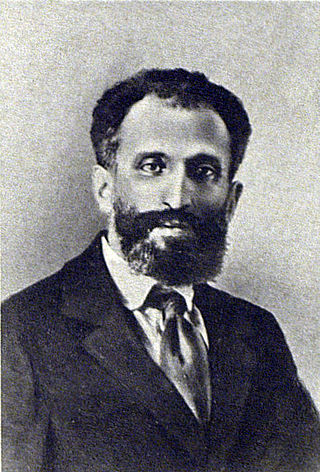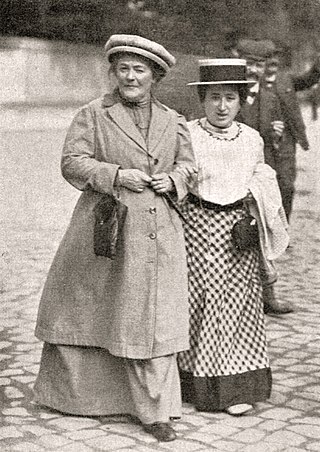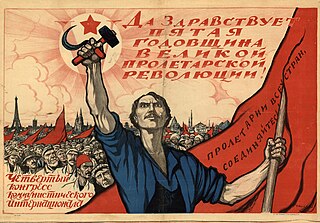A communist party is a political party that seeks to realize the socio-economic goals of communism. The term "communist party" was popularized by the title of The Manifesto of the Communist Party (1848) by Karl Marx and Friedrich Engels. As a vanguard party, the communist party guides the political education and development of the working class (proletariat). As a ruling party, the communist party exercises power through the dictatorship of the proletariat. Vladimir Lenin developed the idea of the communist party as the revolutionary vanguard, when the socialist movement in Imperial Russia was divided into ideologically opposed factions, the Bolshevik faction and the Menshevik faction. To be politically effective, Lenin proposed a small vanguard party managed with democratic centralism which allowed the centralized command of a disciplined cadre of professional revolutionaries. Once a policy was agreed upon, realizing political goals required every Bolshevik's total commitment to the agreed-upon policy.

The Communist International (Comintern), also known as the Third International, was a Soviet-controlled international organization founded in 1919 that advocated world communism. The Comintern resolved at its Second Congress to "struggle by all available means, including armed force, for the overthrow of the international bourgeoisie and the creation of an international Soviet republic as a transition stage to the complete abolition of the state". The Comintern was preceded by the 1916 dissolution of the Second International.
The Third Period is an ideological concept adopted by the Communist International (Comintern) at its Sixth World Congress, held in Moscow in the summer of 1928. It set policy until reversed when the Nazis took over Germany in 1933.

The Peasant International, known most commonly by its Russian abbreviation Krestintern (Крестинтерн), was an international peasants' organization formed by the Communist International (Comintern) in October 1923. The organization attempted to achieve united front relations with radical peasant parties in Eastern Europe and Asia, without lasting success. After failing to make headway with important initiatives in Bulgaria, Yugoslavia, and China in the 1920s, the organization was placed on hiatus at the end of the decade. The so-called Red Peasant International was formally dissolved in 1939.
The Communist University of the Toilers of the East (KUTV) was a revolutionary training school for important communist political leaders. The school operated under the umbrella of the Communist International and was in existence from 1921 until the late 1930s. Part of the university was split into the Moscow Sun Yat-sen University.
The National Minority Movement was a British organisation, established in 1924 by the Communist Party of Great Britain, which attempted to organise a radical presence within the existing trade unions. The organization was headed by longtime unionist Tom Mann and future General Secretary of the CPGB Harry Pollitt.
Moscow Sun Yat-sen University, officially the Sun Yat-sen Communist University of the Toilers of China, was a Comintern school, which operated from 1925–1930 in the city of Moscow, Russia, then the Soviet Union. It was a training camp for Chinese revolutionaries from both the Kuomintang (KMT) and the Chinese Communist Party (CCP) that was split off from the Communist University of the Toilers of the East. Its relationship to the Comintern's International Liaison Department remains unclear.

The 10th Congress of the Russian Communist Party (Bolsheviks) was held during March 8–16, 1921 in Moscow, Russia. The congress dealt with the issues of the party opposition, the New Economic Policy, and the Kronstadt Rebellion, which started halfway through the Congress. The Congress was attended by 694 voting delegates and 296 non-voting delegates.

Wolfgang Leonhard was a German political author and historian of the Soviet Union, the German Democratic Republic and Communism. A German Communist whose family had fled Hitler's Germany and who was educated in the Soviet Union, after World War II Leonhard became one of the founders and leaders of the German Democratic Republic until he became disillusioned and fled in 1949, first defecting to Yugoslavia and then moving to West Germany in 1950 and later to the United Kingdom. In 1956 he moved to the United States, where he was a popular and influential professor at Yale University from 1966 to 1987, teaching the history of communism and the Soviet Union, topics about which he wrote several books. After the Cold War ended, he returned to Germany.

The Irish Worker League was an Irish communist party, established in September 1923 by Jim Larkin, following his return to Ireland. Larkin re-established the newspaper The Irish Worker. The Irish Worker League (IWL) superseded the first Communist Party of Ireland and became Ireland's affiliate with the Communist International.

Osip Aaronovitch Piatnitsky, was a Russian revolutionary and Soviet politician. Piatnitsky is best remembered as head of the International Department of the Communist International during the 1920s and early 1930s, a position which made him one of the leading public faces of the international Communist movement.

Elena Dmitriyevna Stasova was a Russian-Soviet communist revolutionary who became a political functionary working for the Communist International (Comintern). She was a Comintern representative to Germany in 1921. From 1927 to 1937 she was the president of International Red Aid (MOPR). From 1938 to 1946, she worked on the editorial staff of the magazine International Literature.

Joseph Zack Kornfeder (1898–1963), sometimes surnamed "Kornfedder" in the press, was an Austro-Hungarian-born American who was a founding member and top leader of the Communist Party of America in 1919, Communist Party USA leader, and Comintern representative to South America (1930-1931) before quitting the Party in 1934. After his wife was arrested by the secret police during the Great Terror (1937-1938), Zack became a vehement Anti-Communist and testified before the Dies Committee (1939) and Canwell Committee (1948).

The 2nd World Congress of the Communist International was a gathering of approximately 220 voting and non-voting representatives of Communist and revolutionary socialist political parties from around the world, held in Petrograd and Moscow from July 19 to August 7, 1920. The 2nd Congress is best remembered for formulating and implementing the 21 Conditions for membership in the Communist International.
The 1st Congress of the Communist International was an international gathering of communist, revolutionary socialist, and syndicalist delegates held in Moscow which established the Communist International (Comintern). The gathering, held from March 2 to 6, 1919, was attended by 51 representatives of more than two dozen countries from around Europe, North America, and Asia.

The Communist Women's International was launched as an autonomous offshoot of the Communist International in April 1920 for the purpose of advancing communist ideas among women. The Communist Women's International was intended to play the same role for the international women's movement that the Red Peasant International played for poor agrarians and the Red International of Labor Unions played for the international labor movement.

Karl Berngardovich Radek was a Russian revolutionary and a Marxist active in the Polish and German social democratic movements before World War I and a Communist International leader in the Soviet Union after the Russian Revolution.

International Red Aid was an international social-service organization. MOPR was founded in 1922 by the Communist International to function as an "international political Red Cross", providing material and moral aid to radical "class-war" political prisoners around the world.

The 4th World Congress of the Communist International was an assembly of delegates to the Communist International held in Petrograd and Moscow, Soviet Russia, between November 5 and December 5, 1922. A total of 343 voting delegates from 58 countries were in attendance. The 4th World Congress is best remembered for having amplified the tactic of the United Front into a fundamental part of international Communist policy. The gathering also elected a new set of leaders to the Comintern's governing body, the Executive Committee of the Communist International (ECCI).

The Executive Committee of the Communist International, commonly known by its acronym, ECCI (Russian acronym ИККИ - for Исполнительный комитет Коммунистического интернационала), was the governing authority of the Comintern between the World Congresses of that body. The ECCI, established by the Founding Congress of the Comintern in 1919, was dissolved with the rest of the Comintern in May 1943.














